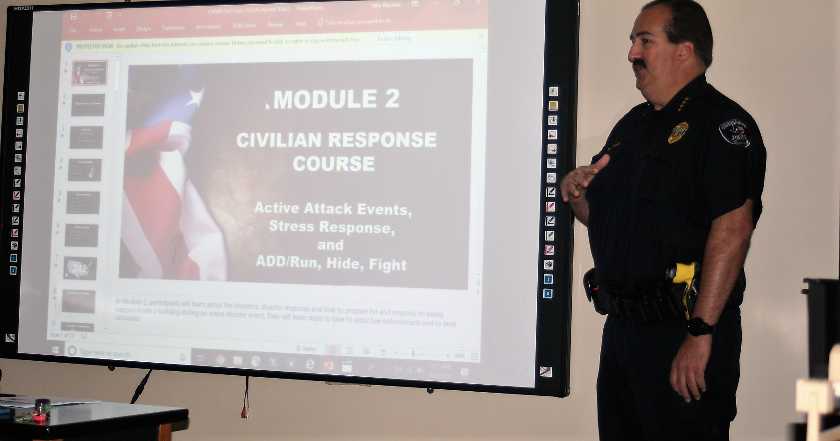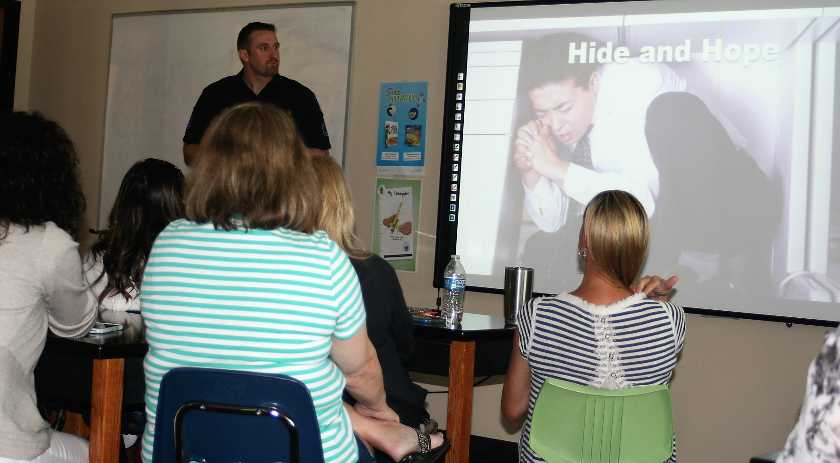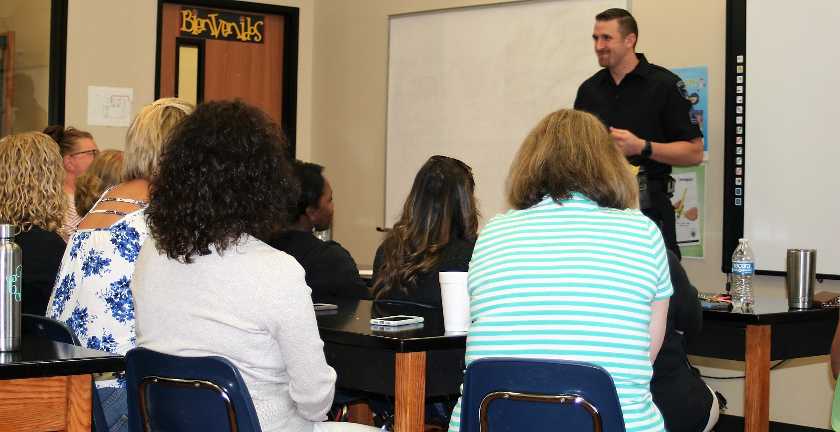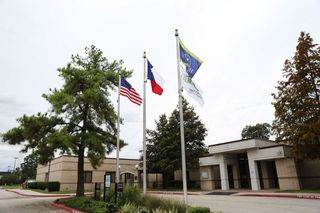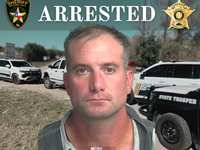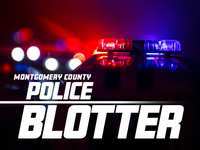- Sections :
- Crime & Public Safety
- Restaurants & Food
- Sports
- More
Categories
Shenandoah Police Department offers active shooter workshop
SHENANDOAH, Texas -- With the countdown on for the start of the 2018-19 school year, school district staff across the nation are in class themselves, updating information needed for a successful school year. In Shenandoah, the Christ Community School staff is no different. But instead of discussing testing, subject requirements and school district calendars, these staff members were learning to ADD --- AVOID, DENY and DEFEND.
Members of the Shenandoah Police Department held a two-hour civilian response training geared toward giving school staff the information needed to save their lives and those of their students in the case of an armed attack on their campus. Based on ALERRT, the course is designed to use research that was based on incidents from the 1966 UT Tower shooting to the 2009 Ft Hood shooting to the Sandy Hook massacre and others along the way. The Texas State University’s ALERRT program is now considered the best research-based active shooter response training in the nation. ALERRT --- Advanced Law Enforced Rapid Response Training ---was created in 2002 as a partnership between Texas State University, San Marcos PD and Hays County Sheriff’s Department to address the need for training for first responders. In 2013 it was named the national standard in active shooter response training by the FBI. More than 130,000 law enforcement officers and 200,000 civilians have since undergone training.
“Run, hide and fight used to be the key response to an armed intruder,” explained Shenandoah Police Chief Raymond Shaw, one of five Shenandoah officers who have undergone the intensive law enforcement training. “Now we have a new concept – ADD – which means Avoid the attacker, Deny access, Defend yourself.”
Shaw reminded the staff that most shooters have one objective: kill as many as you can as quickly as possible. “Our mission is to prevent their success.”
Sgt. Jake Reuvers supplemented his training presentation with video clips from many of the past attacks experienced in the US and around the world. Interviews with survivors emphasized the change in focus from hiding and hoping to live through the attack to making a commitment to living through the situation with as little loss of life as possible.
“Avoid the attacker: be aware of the situations in which you find yourself whether at school, work, shopping or even at church as we saw in the Sutherland shooting,” Reuvers explained. “Reacting when you see something that doesn’t seem right may save your life and those of your friends and loved ones by getting you removed from the developing situation.” Reuvers showed a video in which attendees at a school board meeting sat and watched as the husband of a former employee walked into a meeting, drew on the wall and then pulled a gun. It took two orders to get out, before the audience reacted and left the room, leaving the man with his intended target. In another clip, a stocker alerted coworkers to a man with a gun systematically shooting people as he went through a store. That warning saved the lives of many people that morning.
“Deny access: know your exits, places that you can barricade yourself in if fleeing is not possible. Use your knowledge of the layout to increase your chances of survival,” continued Reuvers. “Lock doors, barricade doors, turn off lights, silence phones… do whatever it takes for you to go home that day.”
And if all else fails, said Reuvers, “Defend yourself: be prepared to fight the dirtiest fight possible to live though that moment. Do not play fair… shift from fear to anger and make a commitment to living.”
After the presentation, staff members had the opportunity to ask questions of the officers in attendance who also included Investigator Jeremy Thompson, Lieutenant Troye Dunlap and Detective Sergeant Joel Gordon. Discussion included things that could be done to facilities to make them safer, things to have scattered around rooms that could be used as weapons if under attack and things to remember, such as an active shooter episode is attempted mass murder and usually happens in a public place with someone who is avenging some wrong they perceive having been done.
The officers urged the staff to pay particular attention to those students and staff that seem to be withdrawn from the group. “While there is no known profile for an active shooter, there may be risk factors that you could recognize before it is too late,” said Reuvers. “History of violence in the family, desensitization to violence (possibly from some of the violent video games kids play), substance abuse, mental illness issues, isolation by others or by their own choice, or even a stalking or harassing behavior exhibited. Instead of watching from afar, get involved, find out what is going on, maybe stop something before it happens.”
The final point that all the officers agree upon was that the identities of mass shooters not be the focus after their arrest or death. A final program of ALERRT is the “Don’t Name Them” program in which journalists are urged to focus less on the suspects and more on the victims, it is hoped that future events can be prevented.
“Focus on the first grade teacher who herded her little ones into a bathroom and made sure each of them knew they were loved in case they were the last words they ever heard … focus on the student who talked about hearing the shooter chambering another round… focus on the wife whose husband lost his life saving others. THEY are the heroes … not someone who acted on their twisted thoughts.”
Members of the Shenandoah Police Department held a two-hour civilian response training geared toward giving school staff the information needed to save their lives and those of their students in the case of an armed attack on their campus. Based on ALERRT, the course is designed to use research that was based on incidents from the 1966 UT Tower shooting to the 2009 Ft Hood shooting to the Sandy Hook massacre and others along the way. The Texas State University’s ALERRT program is now considered the best research-based active shooter response training in the nation. ALERRT --- Advanced Law Enforced Rapid Response Training ---was created in 2002 as a partnership between Texas State University, San Marcos PD and Hays County Sheriff’s Department to address the need for training for first responders. In 2013 it was named the national standard in active shooter response training by the FBI. More than 130,000 law enforcement officers and 200,000 civilians have since undergone training.
“Run, hide and fight used to be the key response to an armed intruder,” explained Shenandoah Police Chief Raymond Shaw, one of five Shenandoah officers who have undergone the intensive law enforcement training. “Now we have a new concept – ADD – which means Avoid the attacker, Deny access, Defend yourself.”
Shaw reminded the staff that most shooters have one objective: kill as many as you can as quickly as possible. “Our mission is to prevent their success.”
Sgt. Jake Reuvers supplemented his training presentation with video clips from many of the past attacks experienced in the US and around the world. Interviews with survivors emphasized the change in focus from hiding and hoping to live through the attack to making a commitment to living through the situation with as little loss of life as possible.
“Avoid the attacker: be aware of the situations in which you find yourself whether at school, work, shopping or even at church as we saw in the Sutherland shooting,” Reuvers explained. “Reacting when you see something that doesn’t seem right may save your life and those of your friends and loved ones by getting you removed from the developing situation.” Reuvers showed a video in which attendees at a school board meeting sat and watched as the husband of a former employee walked into a meeting, drew on the wall and then pulled a gun. It took two orders to get out, before the audience reacted and left the room, leaving the man with his intended target. In another clip, a stocker alerted coworkers to a man with a gun systematically shooting people as he went through a store. That warning saved the lives of many people that morning.
“Deny access: know your exits, places that you can barricade yourself in if fleeing is not possible. Use your knowledge of the layout to increase your chances of survival,” continued Reuvers. “Lock doors, barricade doors, turn off lights, silence phones… do whatever it takes for you to go home that day.”
And if all else fails, said Reuvers, “Defend yourself: be prepared to fight the dirtiest fight possible to live though that moment. Do not play fair… shift from fear to anger and make a commitment to living.”
After the presentation, staff members had the opportunity to ask questions of the officers in attendance who also included Investigator Jeremy Thompson, Lieutenant Troye Dunlap and Detective Sergeant Joel Gordon. Discussion included things that could be done to facilities to make them safer, things to have scattered around rooms that could be used as weapons if under attack and things to remember, such as an active shooter episode is attempted mass murder and usually happens in a public place with someone who is avenging some wrong they perceive having been done.
The officers urged the staff to pay particular attention to those students and staff that seem to be withdrawn from the group. “While there is no known profile for an active shooter, there may be risk factors that you could recognize before it is too late,” said Reuvers. “History of violence in the family, desensitization to violence (possibly from some of the violent video games kids play), substance abuse, mental illness issues, isolation by others or by their own choice, or even a stalking or harassing behavior exhibited. Instead of watching from afar, get involved, find out what is going on, maybe stop something before it happens.”
The final point that all the officers agree upon was that the identities of mass shooters not be the focus after their arrest or death. A final program of ALERRT is the “Don’t Name Them” program in which journalists are urged to focus less on the suspects and more on the victims, it is hoped that future events can be prevented.
“Focus on the first grade teacher who herded her little ones into a bathroom and made sure each of them knew they were loved in case they were the last words they ever heard … focus on the student who talked about hearing the shooter chambering another round… focus on the wife whose husband lost his life saving others. THEY are the heroes … not someone who acted on their twisted thoughts.”
Comments •

